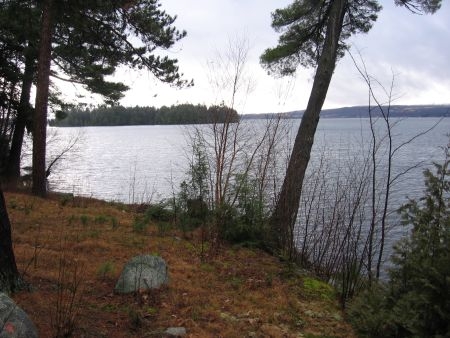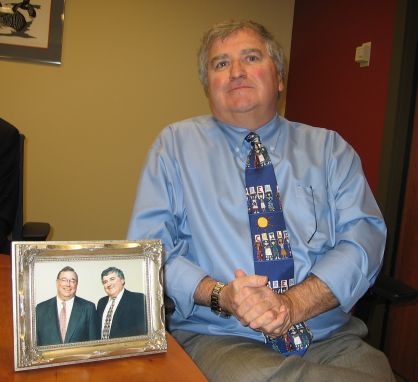
(Host) When a wealthy Northeast Kingdom man died two years ago, he left almost two miles of property along Lake Memphremagog to the government. Michael Dunn of Derby wanted to preserve his land forever for the public to enjoy.
But there’s a catch. The U.S. Fish and Wildlife Service hasn’t yet accepted the gift. And if it doesn’t act by September of next year, Dunn’s will requires that this valuable asset go to the Museum of Modern Art in New York City. And if that happens, it’s likely that the lakefront land would be sold and developed.
VPR’s John Dillon has this special report on the effort to protect this legacy of conservation.
(Rushing stream, crunch of leaves)
(Dillon) Lake Mempremagog straddles the international border. The rivers that feed it flow north from Vermont, but about two-thirds of the big lake lies in Quebec.
Like the lake he loved, Michael Dunn was also a man of both countries. And his will specified that his 880 acres of farm and forest be kept open for the citizens of the U.S. and Canada.
(Livingston) "When we visited here with the Quebec Agency of Natural Resources and officials with the Fish and Wildlife Service, conveniently a spectacular pair of loons surfaced very close to this point."
(Ravens calling)
(Dillon) There are no loons today, just some ravens circling overhead. Gil Livingston, the president of the Vermont Land Trust, leads a hike through dark hemlock woods on the Dunn property. He crosses small streams to a rocky cliff north of Eagle Point on the east shore of Memphremagog.
(Livingston) "So we’re on the Canadian line with the boundary marker behind us, looking across the lake due west. So from this point on the Canadian side, there’s about 3,200 linear feet of undeveloped shoreline."
(Dillon) South of the border, there’s more undeveloped lakefront. Nearby are farm fields, several houses, a pristine, protected cove, and 200 acres of wetlands. Even on this rainy day – when the slate sky matches the dark water – the beauty of the place shines through. Livingston says the property has important ecological and social values — especially because public access to the lake is so hard to find.
(Livingston) "We would go through heroic efforts to buy a piece of property like this. The notion that Michael Dunn, through his commitment both to the natural resources here and the local community, would provide this as a free opportunity like this is unparalleled. Unparalleled. And the sun’s coming out!"
(Dillon) Livingston and the Vermont Land Trust are working with various government agencies to make sure that Dunn’s wishes are carried out.
 But who was Michael Dunn? What prompted his generous gift to the public?
But who was Michael Dunn? What prompted his generous gift to the public?
(Marsh) "I’m not sure Michael knew what he was worth. Because he wasn’t the type to care."
(Dillon) Stephen Marsh is president and CEO of the Community National Bank in Derby. He knew Dunn for more than 30 years. And in a conference room at the bank, Marsh reminisces about his old friend. He describes Dunn as frugal, private, a person not taken with the trappings of wealth.
(Marsh) "He was concerned about politics. He was concerned about his community. And very active on a pile of non-profit boards. You have to give him credit; he inherited a lot of money, and he grew it."
(Dillon) Marsh and Dunn served together on several of those non-profit boards. And Marsh said they got to be good friends driving to and from night meetings. Dunn was originally from Canada. The Memphremagog property – which Dunn added to over the years – was at first the family’s summer home.
(Marsh) "I think after the rise of the Quebecois in Quebec, he found that he’d rather spend more time down here, and he became a U.S. citizen. And eventually they moved down here full-time and his mom moved down here full-time. … Had a great interest in wildlife, didn’t hunt and didn’t fish, but enjoyed watching them, and enjoyed watching others have success doing it."
(Dillon) Dunn collected fine watches and amassed an impressive collection of Canadian art. But he never married and he left no immediate heirs for his $10 million fortune or his land. His will stipulated that his money go to the Museum of Modern Art in New York City. It’s the largest unrestricted gift the museum has ever received. But Dunn never told the museum about his bequest.
(Marsh) "Michael wasn’t the type to do that. We had a gathering of folks that knew Michael after he passed away. And I think what we found out was that we all knew a little bit, but none of us knew the whole story. He was just very private, and that’s the way he wanted it. He also liked the shock factor."
(Dillon) Dunn’s wishes for the lakefront property weren’t a complete surprise. He had told Stephen Marsh about his plans. And he made it clear in his will. Mark Frederick is president of Community Financial Services group, which serves as trustee for Dunn’s estate.
(Frederick) "Michael left a personal letter with his estate plan. And he stated that it was his desire that his land be made into some sort of park, and he also indicated that hopefully it would be lovelier for the people around Eagle Point after the government took it over."
(Dillon) But Dunn set a time limit on his gift. His estate plan says if the federal government doesn’t accept the property by September 2010, the asset will go to his prime beneficiary – the Museum of Modern Art in New York.
The timing puts pressure on those who want to see the land protected. Mark Frederick says his role is to carry out Dunn’s intentions and protect the land. But as a representative for the trustee, he has another role as well.
(Frederick) "To maximize the value of the estate for any beneficiaries. And so that’s the quandary here, is that if the governments don’t take the property, then technically our job here is to maximize the value of the property. And that might not at all be consistent with leaving it in its present state."
(Dillon) The wheels of government can turn slowly. The Dunn estate at first didn’t get very far in their contacts with the U.S. Fish and Wildlife Service. That’s when the estate asked the Vermont Land Trust to help with the transfer.
Janet Kennedy is refuge supervisor for the Fish and Wildlife Service in Hadley, Massachusetts. She said the service does hope to acquire the land by next year’s deadline. The current plan is for the Fish and Wildlife service to form a partnership with the state of Vermont, which would manage the property.
State Natural Resoures Secretary Jonathan Wood said Vermont already manages land nearby the Dunn estate, including wetlands on the shores of Memphremagog. He said his agency should be able to work out a management plan with the federal government.
(Wood) "It certainly is a property worthy of conservation and a great opportunity for the local folks as well as statewide people to enjoy access to a major lake."
(Dillon) Those working on the estate say it’s a once-in-a lifetime opportunity for land protection. Gil Livingston of the Vermont Land Trust worries about what would happen if the government misses the deadline.
(Livingston) "There is a trustee obligation to, I think at that point, market the property. And it’s a breathtaking place where you could easily imagine a constellation of houses on the lake, the lake frontage being divided into individual private ownerships, the beautiful farm fields hosting probably very nice, tasteful houses. But not a place available to the public, not a place where wildlife values would be honored. And certainly not something that Michael Dunn had in mind."
For VPR News, I’m John Dillon in Derby.